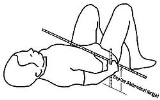
Sagittal Abdominal Diameter
Encyclopedia

Coronary disease
Coronary disease refers to the failure of coronary circulation to supply adequate circulation to cardiac muscle and surrounding tissue. It is already the most common form of disease affecting the heart and an important cause of premature death in Europe, the Baltic states, Russia, North and South...
, with higher values indicating increased risk independent of BMI
Body mass index
The body mass index , or Quetelet index, is a heuristic proxy for human body fat based on an individual's weight and height. BMI does not actually measure the percentage of body fat. It was invented between 1830 and 1850 by the Belgian polymath Adolphe Quetelet during the course of developing...
.
For persons of normal BMI, SAD should be under 25 centimetres (9.8 in). The amount this measure exceeds 30 centimetres (11.8 in) correlates to increased cardiovascular
Cardiovascular disease
Heart disease or cardiovascular disease are the class of diseases that involve the heart or blood vessels . While the term technically refers to any disease that affects the cardiovascular system , it is usually used to refer to those related to atherosclerosis...
risk and insulin resistance
Insulin resistance
Insulin resistance is a physiological condition where the natural hormone insulin becomes less effective at lowering blood sugars. The resulting increase in blood glucose may raise levels outside the normal range and cause adverse health effects, depending on dietary conditions. Certain cell types...
. SAD measure of men in their 40s, greater than 25 cm, also predicts significantly higher risk of Alzheimer's disease
Alzheimer's disease
Alzheimer's disease also known in medical literature as Alzheimer disease is the most common form of dementia. There is no cure for the disease, which worsens as it progresses, and eventually leads to death...
30 years later. An article in Annals of Neurology
Annals of Neurology
Annals of Neurology is a peer-reviewed medical journal covering neurology....
links visceral fat to lower brain volume.
A related measurement is Supine Abdominal Height (SAH), the abdominal height as measured in the supine position
Supine position
The supine position is a position of the body: lying down with the face up, as opposed to the prone position, which is face down, sometimes with the hands behind the head or neck. When used in surgical procedures, it allows access to the peritoneal, thoracic and pericardial regions; as well as the...
. The SAH method is easier for self-monitoring, but gives slightly lower results due to gravity; the values are not directly comparable.
See also
- Central obesityCentral obesityAbdominal obesity, colloquially known as belly fat or clinically as central obesity, is the accumulation of abdominal fat resulting in an increase in waist size...
- Waist-hip ratio
- Body mass index (BMI)Body mass indexThe body mass index , or Quetelet index, is a heuristic proxy for human body fat based on an individual's weight and height. BMI does not actually measure the percentage of body fat. It was invented between 1830 and 1850 by the Belgian polymath Adolphe Quetelet during the course of developing...
- Body volume indexBody volume indexThe Body Volume Index is a new measurement for human obesity that has been proposed as an alternative to the Body Mass Index .BMI is based on a measurement of total mass, irrespective of the location of the mass, but BVI looks at the relationship between mass and volume distribution...
- Body fat percentageBody fat percentageA person's body mass percentage is the total weight of the person's fat divided by the person's weight and consists of essential body fat and storage body fat. Essential body fat is necessary to maintain life and reproductive functions. The percentage of essential body fat for women is greater than...
- Index of Central Obesity

